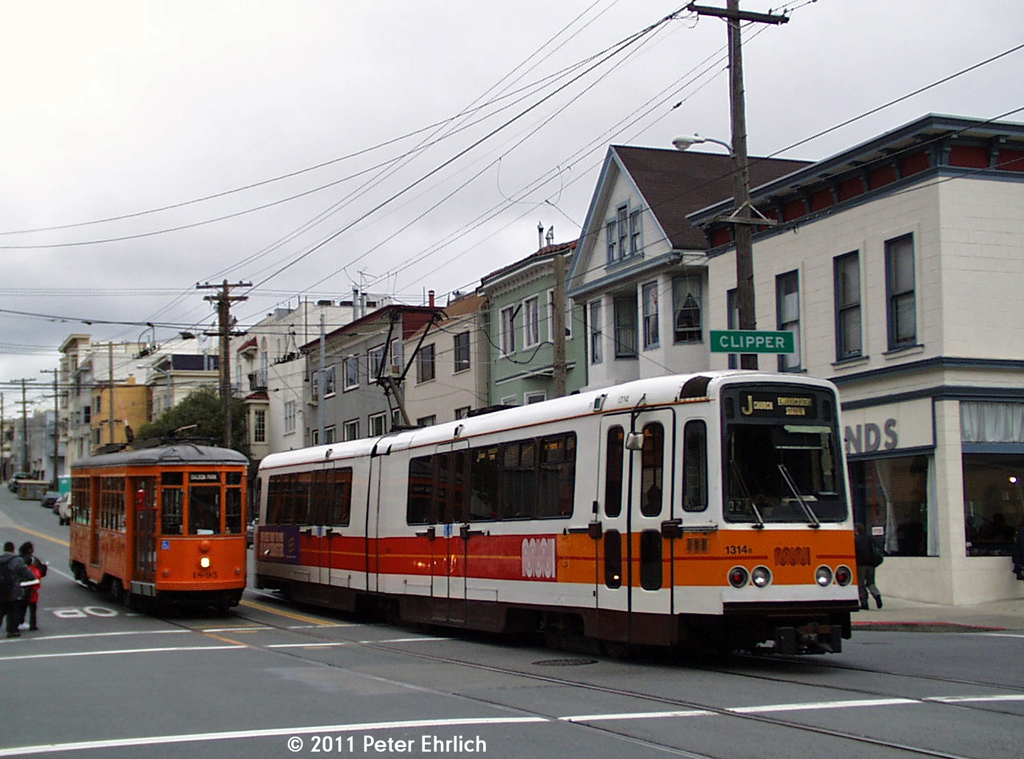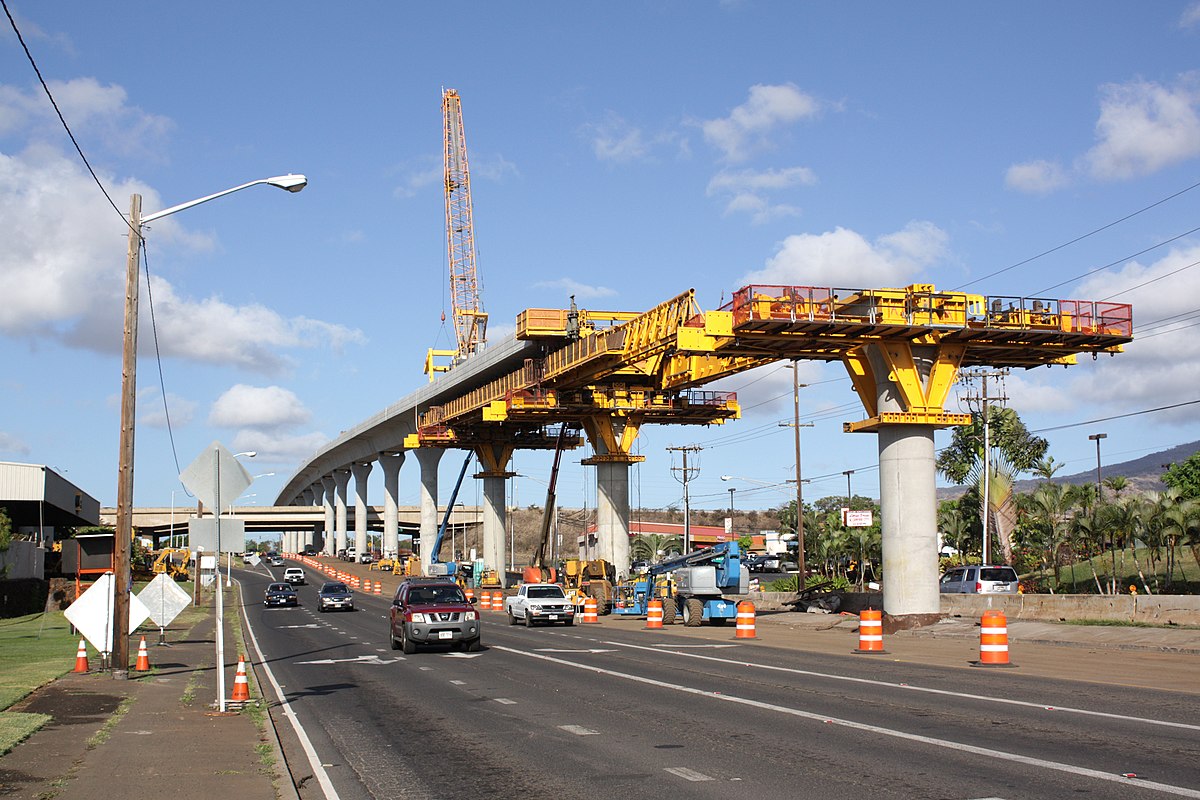SLC has the widest streets (132'). It's a quirk resulting from our large blocks, and surveyors convention that the ratio of street width to block size be 5:1 (Our blocks are 660', so it's a 10:2 ratio). In a very limited number of cases, it's handy, as it permits us to do things like have a 24' LRT guideway with 6 lanes of traffic. But most of the time, it's just acres of asphalt. (132' ROW means each blockface represents two acres of asphalt). Some of that gets used for parking, some of it for bikelanes. In other places, we've expanded the 'parkstrip' between sidewalk and curb out 20'. In other places, we've added planted medians with trees.
Showing posts with label right of way. Show all posts
Showing posts with label right of way. Show all posts
Tuesday, October 9, 2018
Thursday, May 18, 2017
Grades of Guideway
Right of way comes in three grades: 'Separated', 'Exclusive', 'Dedicated'.
Dedicated is the lowest grade. A lane nominally belongs to one mode, an obligation more commonly honored in the breach. Think of HOV lanes and bicycle lanes.

Exclusive can be though of as 'excluding'; exclusive use is maintained through barriers. Exclusive guideway is never continuous--there are always gaps in it, typically at intersections.

Separated is similar to exclusive, except that it is continuous. Typically, this requires grade separation, if only where the guideway intercepts other rights of way.

Heavy railways (commuter rail, freight rail) have separated guideway, for the simple reason that trains can't stop quickly. Where they must cross other roads 'time-separation' (railroad gates) are used. Where this generates unacceptable levels of delay for the cross-streets (a train can take minutes to pass) grade-separation is used. Typically, this requires an overpass for cars traveling over the road. In cases where there are too many roads, the railroad may be buried. The 'cut and cover' model of a trench with a roof were how the first subways were built. (Actual tunnels came later). In some cases (Alameda Corridor, in LA), digging an uncovered trench for the railway is simpler than many bridges.

Light railways have a mix of Separated, Exclusive, and Dedicated. Most light railways make use of some portion of old freight track, which are already time-separated. Some light rail systems provide Separated guideway by running down the center of freeways (Portland) or on elevated structures (Los Angeles, Salt Lake). Light rail on streets (a train in in tram-mode) typically has Exclusive guide way, with intermittent sections of Dedicated guide way. San Diego and Buffalo, two or the first cities to build light rail, made use of this. Light rail vehicles weigh less than heavy rail vehicles, and so can stop more rapidly. Streetcar/Tram vehicles weight even less, so they can stop faster and are even more suitable for on-street use.
The decision to use either Exclusive or Dedicated right of way is one of cost and safety. Without barrier separation, conflicts with turning cars results in accidents. Sadly, even Exclusive guide way is no guarantee against human stupidity.


Higher barriers, which prevent drivers from crossing them, may be safer. The trade-off is that first responders/emergency vehicles lose the ability to make left-turns and U-turns across the street, due to the curb. To accomodate this, curb heights vary between systems.

There is a fourth grade of right of way: Shared. This is what regular buses have. It offers no speed advantage to the transit vehicle over a regular automobile. Once the time consumed with exiting the flow of traffic, boarding and alighting passengers, and re-entering the flow of traffic is considered, transit vehicles in shared right of way travel at about half the speed of an automobile.
In contexts where right of way is scarce or political will lacking, Shared and Dedicated guide way are more common, to the detriment of transit vehicle speed, reliability and safety. A streetcar operating in shared guide way has minimal advantage over a bus. (The minimal advantage is that is cannot leave the flow of traffic, and so loses less time entering/leaving the traffic lane).

BRT systems are cheap to build, and largely unregulated. Consequently, they vary wildly. They make use of every kind of guide way.
Grade-Separated

Time-Separated
(LA Orange Line), for a time. Drivers ignored them, causing crashes. It still experiences issues with drivers running red lights. Grade-separation is in the works.
Exclusive - Fenced

Exclusive - Curb
Dedicated - Median

Dedicated - Side

Wednesday, October 19, 2016
Type of Right of Way: separated, exclusive, dedicated and mixed
For the purpose of argument, consider these the basic types of guide-way for urban transportation: Separated, Exclusive, Dedicated and Mixed.
Separated means grade-separation, either elevated or underground. There is also at-grade seperation, which is what freight lines (and most light rail systems) use, railroad gates are used to provide time-separation where roads and railways intersect.
Exclusive means 'transit only', a prohibition enforced with physical separation, typically in the form of either a Jersey barrier or a curb.
Dedicated also means 'transit only', but without the physical separation of a barrier. Typically, this is what is used for bus-lanes. Lacking physical barriers preventing entry and exit, enforcing it is more difficult. It gets used because it is a) cheap, and b) emergency response agencies oppose physical barriers that limit their ability to make U-turns across streets.
Mixed is 'mixed traffic', where the transit vehicle operates like a private vehicle.
There are some other, more exotic variants, but most of those aren't relevant, so I'll cover them in another post.
Separated means grade-separation, either elevated or underground. There is also at-grade seperation, which is what freight lines (and most light rail systems) use, railroad gates are used to provide time-separation where roads and railways intersect.
Exclusive means 'transit only', a prohibition enforced with physical separation, typically in the form of either a Jersey barrier or a curb.
Dedicated also means 'transit only', but without the physical separation of a barrier. Typically, this is what is used for bus-lanes. Lacking physical barriers preventing entry and exit, enforcing it is more difficult. It gets used because it is a) cheap, and b) emergency response agencies oppose physical barriers that limit their ability to make U-turns across streets.
Mixed is 'mixed traffic', where the transit vehicle operates like a private vehicle.
Tuesday, August 16, 2016
Crossings
Offhand, there are bare handulf ways for a transit line to cross a roadway.
- Grade-separated
- Overpass/viaduct/elevated structure
- Underpass/tunnel/escavation
- Level-crossing
- Time separated
- Railroad Gates
- Traffic Signal
- A metro is a system where both the running way and crossings are grade-separated.
- A pre-metro is a system (or line) where only the crossings are grade separated.
- 'Rapid Rail' is the pupae form between metro and pre-metro, where the most urban sections have all their right of way grade separated. The M/ART systems did this.
Both tend to be heavy rail systems. Or rather, heavy rail systems tend to be either metros. While its well known that 'you can't steer a train', it's less well known 'You can't stop a train' (at least in any reasonable period of time. Ie, if you park a vehicle on the tracks, by the time the driver sees it, it is too late to stop. "With so much steel and steam, I won't slow it down at all". This has been the cause of a number of memorable train crashes, and much conductor trauma.
And that is the problem with level crossings. Grade-separated crossings remove the 'conflict' between things, with certainty, but are costly to construct. (They have to be able to support a bridge filled with full-loaded semi-trailer trucks, while never exceeding a 5% grade, and being as wide as the roads leading to them).
Level crossings are much much less safe. Rather than being grade-separated, they are time-separated. When two moving vehicles could be in the same place, this is known as a 'conflict'. When two vehicles attempt to be in the same place, this is known as a 'crash'. Playing 'chicken' with a train ends badly--the train is never going to swerve. Yet drivers managed to run red-lights, and drive around lowered freeway gates with depressing frequency. (It is rare for the driver to survive).
Monday, August 6, 2012
"UTA only knows how to build Light Rail'
I was looking at the illustrations for Sugarhouse Streetcar, and the
criticism that UTA only knows how to build light rail sings true. Sugarhouse Streetcar looks like a TRAX line--a dedicated corridor, with a gravel bed and fences along both sides. I've ridden streetcar systems in Portland and Barcelona. Like the name suggests, streetcars run in the street...sometimes on the edge, sometimes down a center median.
UTA built most of the TRAX system using old railway corridor (Sandy--SLC--Mid-Jordan) and seems to be comfortable and familiar doing so. It certainly makes sense to do so. Building in an existing corridor reduces utility conflicts, and makes the property acquisition for right of way relatively simple.
Cost-wise, I know that the per-mile costs associated with running TRAX light rail through Salt Lake City on city streets was fairly high compared to the initial Sandy-Salt Lake stretch, and certainly more complex in terms of traffic engineering, and the need to come to negotiated agreements with UDOT and Salt Lake City.
The next phase of the Sugarhouse Streetcar will have to be along roadway (east on 21st, or north on 1100 East), so UTA is going to have learn how to build 'real' streetcar, and not just TRAX-lite.
TRAX shares right of way with automobiles only at intersections (typically left turn arrows). The rest of the street right of way is protected by curbs or jersey barriers separating the train from auto-traffic. That wasn't originally so, but a two or three cars got themselves t-boned as they tried to make (illegal) turns across the TRAX right of way). Hence, curbs.
But that's not something that is going to work with streetcar, which is going to have to run 'in traffic', right with the cars. That it is possible to do so is really the big difference between the two vehicles. A light rail car weights about 98,500 lbs, while a streetcar weights about 30,000 lbs, or about 1/3 as much. Thus, faster, more responsive stopping capacity.
UTA built most of the TRAX system using old railway corridor (Sandy--SLC--Mid-Jordan) and seems to be comfortable and familiar doing so. It certainly makes sense to do so. Building in an existing corridor reduces utility conflicts, and makes the property acquisition for right of way relatively simple.
Cost-wise, I know that the per-mile costs associated with running TRAX light rail through Salt Lake City on city streets was fairly high compared to the initial Sandy-Salt Lake stretch, and certainly more complex in terms of traffic engineering, and the need to come to negotiated agreements with UDOT and Salt Lake City.
The next phase of the Sugarhouse Streetcar will have to be along roadway (east on 21st, or north on 1100 East), so UTA is going to have learn how to build 'real' streetcar, and not just TRAX-lite.
TRAX shares right of way with automobiles only at intersections (typically left turn arrows). The rest of the street right of way is protected by curbs or jersey barriers separating the train from auto-traffic. That wasn't originally so, but a two or three cars got themselves t-boned as they tried to make (illegal) turns across the TRAX right of way). Hence, curbs.
But that's not something that is going to work with streetcar, which is going to have to run 'in traffic', right with the cars. That it is possible to do so is really the big difference between the two vehicles. A light rail car weights about 98,500 lbs, while a streetcar weights about 30,000 lbs, or about 1/3 as much. Thus, faster, more responsive stopping capacity.
Subscribe to:
Posts (Atom)